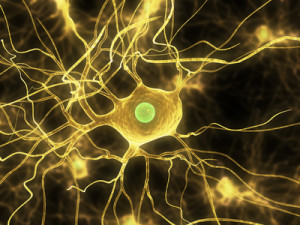 What exactly is MS and how does it affect someone with this diagnosis? We provide answers to these questions in this overview.
What exactly is MS and how does it affect someone with this diagnosis? We provide answers to these questions in this overview.
Multiple Sclerosis, or MS, is an incurable autoimmune disease. A disease is classified as autoimmune when, for still-unknown reasons, the illness-fighting “T cells” in a person’s body begin attacking normal, healthy cells, mistaking them for diseased or foreign cells. In multiple sclerosis, the T cells attack cells called oligodendrocytes in the central nervous system, which includes the brain, spinal cord, and optic nerves. These oligodendrocytes produce a material called myelin that makes up the “fatty sheath” or coating around the axons, or tails, of nerve cells.
Your nerve cells are the communicators in your body. They send messages in the form of electrical impulses to and from your brain. You can think of them as electrical wiring and the myelin sheath around them as the wire coating, which helps the nerves send messages about sensation and movement quickly and efficiently. For example, when you touch a hot pot on the stove, your brain tells your body to move your hand away before you even realize it’s hot. This is because the nerve endings in your hand send a quick message to your brain, which responds with a message for your muscles to pull your hand away. We’ve all done it and it happens pretty fast, right?! Well, when someone has MS, the protective myelin sheath is damaged or destroyed by the T Cells, so those messages can be delayed or blocked completely from getting to where they need to go. The areas where myelin damage occurs are called scars or more commonly “lesions,” and the term Multiple Sclerosis actually means “multiple scars.”
Because of the scars that block or delay messages, people with MS experience a wide variety of symptoms, depending on the severity of their specific case, which can also vary widely. These symptoms may include any or all of the following:
- Burning or tingling sensation in the extremities (arms and legs), hands, and bottoms of the feet
- Numbness in the extremities, hands, or face
- Speech troubles
- Vision problems (e.g. double vision; or temporary, partial, or total blindness)
- Weakness in arms and legs
- Muscle spasms or tremors
- Cognitive issues (e.g. forgetfulness, searching for words, etc.)
- Fatigue
- Difficulty walking
- Incontinence, or loss of bladder control
- Sexual dysfunction
- Clumsiness or coordination difficulties
- Balance problems, or vertigo
- Depression
- Partial or total paralysis
When a person with MS experiences any or all of these symptoms, carrying out the day-to-day activities normally could become difficult. Fortunately, there tend to be some In Home Care Services For Disabled Children and adults that can provide assistance with the everyday tasks to make the life of the unfortunate ones, a little easy.
There are four types of MS, which we’ve outlined here:
- Relapsing Remitting (RRMS): Relapsing Remitting Multiple Sclerosis is the most common form of the disease. It is characterized by relapses or “attacks” (periods of symptom exacerbation or flare-ups), and remission (periods of little or no disease activity or symptoms). These periods can last for just a few days or up to several months.
- Secondary Progressive MS (SPMS): Secondary Progressive MS is characterized by fewer periods of remission. This means that nerve cells are being broken down more continuously; thus, disability can be more severe. Those with this condition can become completely dependent on family members or caregivers (who can be found by searching for keywords like disability support sunshine coast or elsewhere on the Web). Know that it is possible that those suffering from this disease will need assistance for completing their daily tasks like sling transfers and bowel care. As a result, it might even persist during periods of remission, requiring you to file a TPD Insurance claim. According to the National MS Society, of the 85 % of people who are diagnosed with RRMS, approximately half will transition to SPMS within 10 years, and most will transition within 25 years.
- Primary Progressive MS (PPMS): This type of MS begins with mild disability that increases slowly but steadily over time with no periods of remission. According to the Mayo Clinic, only about 15% of people who are diagnosed with MS have this type of the disease.
- Progressive Relapsing MS (PRMS): PRMS is the least common type of Multiple Sclerosis, and it is characterized by a combination of steady disease progression (worsening of symptoms and increased disability) and flare-ups. This may mean that over time the need for a wheelchair and/or a scooter could become serious. If this is the result, then looking into professional repairs for mobility scooters and wheelchairs in case of a glitch or breakdown is essential, as they don’t want to be without their mode of transportation.
People with MS are typically diagnosed between the ages of 20 and 40, with pediatric MS being much less common. Statistics show that women are more likely to get MS than men.
According to the National Institute of Neurological Disorders and Stroke, although MS can “sometimes cause severe disability, it is only rarely fatal and most people with MS have a normal life expectancy.” Of the approximately 2.5 million people around the world who have MS, about 400,000 of them live in the United States.
This article was reviewed by Dr. Wendy S. Vargas.
To learn more about MS and keep up with the latest news in MS research, follow MS HOPE Foundation on Facebook and Twitter.
Tags: blurred vision, blurry vision, burning sensation, depression and MS, MS, ms symptoms, multiple sclerosis, nerve cells, numbness, oligodendrocytes, spasticity and MS, symptoms of MS, tingling in hands

